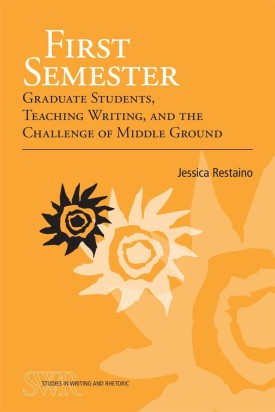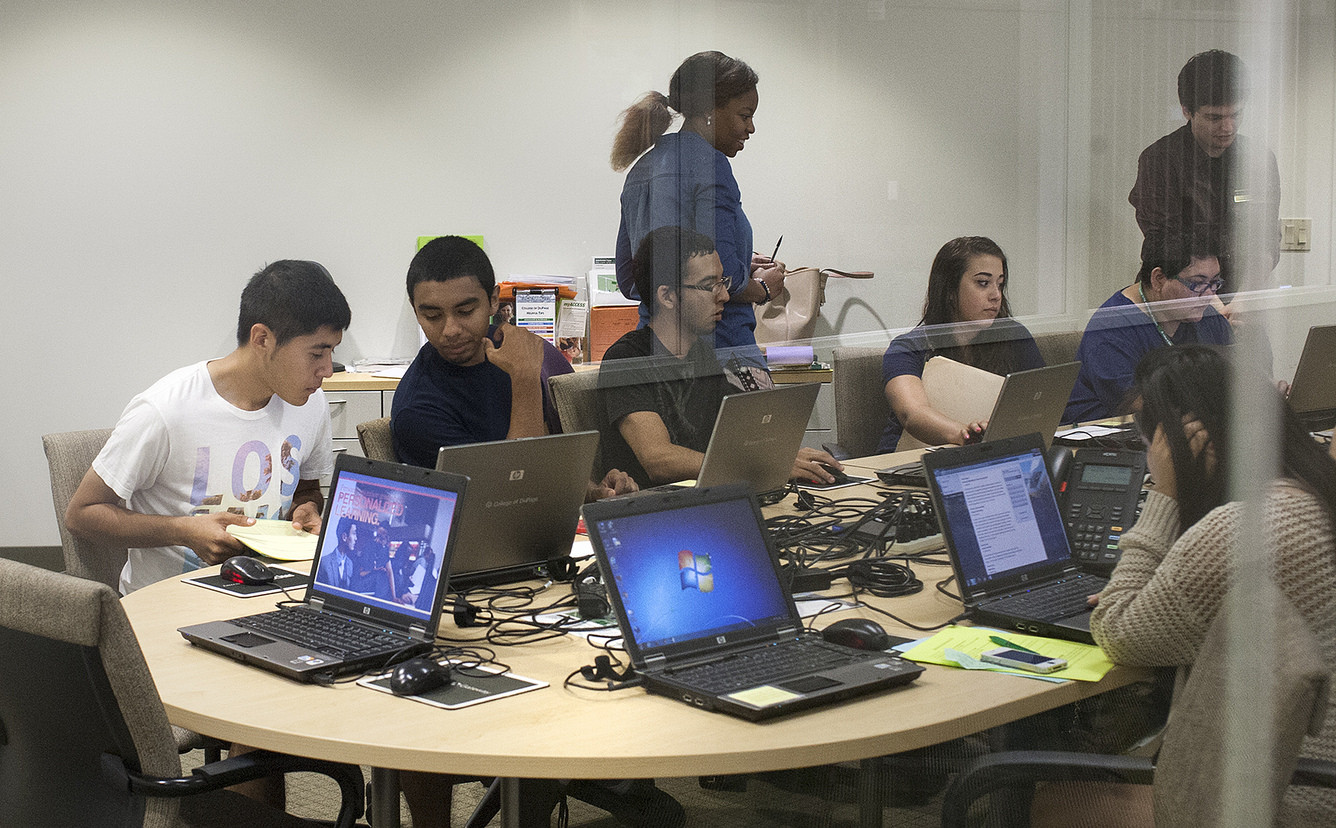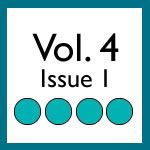Book Review: Restaino’s First Semester
Restaino, Jessica. First Semester: Graduate Students, Teaching Writing, and the Challenge of Middle Ground. CCCC Studies in Writing & Rhetoric. Carbondale: Southern Illinois UP, 2012. Print.
There is no single way to suffer; there is no timeless or spaceless universal shape to suffering. — Arthur Kleinman and Joan Kleinman, “The Appeal of Experience; The Dismay of Images: Cultural Appropriations of Suffering in Our Times.”
 As I prepare to teach writing for the first time, Jessica Restaino’s First Semester:
As I prepare to teach writing for the first time, Jessica Restaino’s First Semester:
Graduate Students, Teaching Writing, and the Challenge of the Middle Ground offered me a relatable narrative to the struggles I am experiencing while navigating my institution’s composition program. Focusing on four graduate students teaching at a state college, “Public U,” Restaino’s text alternates between individual narrative and critical theory (Restaino 3). She grounds her analysis in Hannah Arendt’s concepts of labor, work, and action and uses them to interpret her students’ endeavors to complete their first teaching assignments. Restaino’s dual research model gave me the impression of an embedded journalistic approach, one that combines active participation with written coverage. By inserting herself into the text, Restaino narrates and works to alleviate the struggles she saw her student teachers experiencing.
Shuttling between case study and critical theory, Restaino deploys the ethical framework Arthur and Joan Kleinman recommend in “The Appeal to Experience.” They argue that to truly account for the suffering of others, one must place oneself in their position, in the form of embedded journalism. One must situate oneself within the specific cultural narrative of those they seek to help, because, as the quote that initiates this review indicates, there is no universal way to experience suffering. Suffering constitutes the lived, social realties of those who experience it and to fully report it requires a personal commitment to the experience of the other. Restaino uses embedded journalistic method by providing emotional support for those struggling through their first semesters of teaching. Her text acknowledges and works from the understanding that stress and hardship emerge from a collective conscious—no one struggles alone. By actively incorporating herself into the story, Restaino’s text argues that any analysis of suffering must come from a specific locale, that there is no “essential” way to categorize student-teacher struggles. Ultimately, Restaino’s book succeeds in its goals to find a middle ground between composition theory and acknowledging the struggles of student teachers. Readers will find the book helpful due to its dedication to the negotiations that student teachers must attempt to balance the differences between composition theory and lived classroom experience.
Not many texts have attempted the theoretical/practical blending First Semester undertakes. Restaino places her work within the tradition of books like Sidney Dobrin’s Don’t Call It That: The Composition Practicum, Tina Lavonne Good and Leanne B. Warshauer’s In Our Own Voice: Graduate Students Teaching Writing, and Joseph Harris’s A Teaching Subject: Composition Since 1966. She does so by entering herself into discussions about the relationship between teaching assistants and program administration. However, Restaino differentiates herself through her mediation between storytelling and theoretical analysis. She explains, “this interaction between theory and practice is . . . an effort to understand questions and possibilities relevant to one local community that may, ultimately, raise new questions and possibilities when applied to other teaching contexts” (Restaino 3). By offering an embedded look into “one local community,” Restaino bridges the gulf between how-to guides and theoretical inquiry, a method of analysis missing in many considerations of composition instruction (3). Although her interweaving of theory and practice may not evenly apply for all readers, program administrators and graduate students alike will find valuable information in Restaino’s text.
Restaino’s embedded journalistic methodology provides a useful bridge between theory and practice that the field of rhetoric and composition should find particularly cogent. Going through the composition practicum myself, I appreciated Restaino’s mentorship and narration of the stories of those who struggled through the practical application of rhetoric and composition theories. By melding theory and praxis, Restaino creates a journalistic method that should make anyone in the field of rhetoric and composition feel affirmed in their vocation. Arguing that journalism must situate itself in local action, Kleinman and Kleinman claim that the information generated must flow up into globalized policy-making strategies (18). The field of rhetoric and composition applies this same ethical model, using theoretical abstraction to provide insight into local contexts. Restaino names this framework the “middle ground,” asserting that writing theorists must think about real-life situations when using theoretical inquiry (Restaino 16). In this middle ground, Restaino argues a space must be carved for graduate students teaching their first courses.
Restaino organizes her book around Hannah Arendt’s model of labor, action, and work first published in The Human Condition. Her chapters navigate through each component and pilot between Arendtian analysis and specific case studies from Public U to do so. Taken together, the chapters provide a comprehensive study of how graduate student workers produce politically relevant and important moments of composition theory. Each chapter of First Semester offers a unique and interesting perspective on some of the long-standing theoretical debates within the field of rhetoric and composition. By focusing on graduate students, Restaino’s text forces the more abstract composition theories to confront the student teachers putting them into action in the classroom. In particular, I found Restaino’s analysis about process pedagogy in chapter two especially compelling. In this chapter, Restaino equates day-to-day classroom management to Arendt’s concept of labor, “the giant task of staying alive” (9). Restaino articulates labor in terms of graduate students’ struggles to hold their heads “above the water for any length of time” (25). She explains that class preparations and actual teaching time can behave like labor, forcing graduate students into stressful situations just to make their courses function. Although Restaino insists that process theory has gone out of style, she explains that most writing institutions still use it in their first-year writing courses. Because of this, many graduate students experience a divorce between the theoretical aspects of process and daily classroom management. Restaino uses Tess’s narrative to explicate her critique of process theory. Though Tess, a Caucasian woman who received her undergraduate degree at Public U, read process theory in her teaching practicum, she did not know what to do with the “paper discussion” days marked on her syllabus and resorted to endlessly editing her students’ papers (28). Restaino uses Tess’s difficulties to produce a model “for thinking about the consequences of dangerous laboring, for recognizing such laboring when it occurs, and for rethinking scenarios to ultimately disrupt them” (37). By disclosing how process theory caused Tess to suffer through an unmanageable workload, Restaino’s text helps readers consider process from the standpoint of those who must teach it. For me, Restaino’s efforts to document labor performed an ethical moment of storytelling. Her choice to speak from the standpoint of those struggling through the potentially endless aspects of classroom management helped me think about the possible havoc process pedagogy may produce in graduate students’ classrooms.
Unlike chapter two’s gloomy depictions of student teaching, I found in chapter three a hopeful approach to graduate instructorship, one that gave me confidence about my experiences teaching writing. Using Christopher Higgin’s reformulation of Arendt’s work on education, Restaino lays out the potential for graduate students to produce work and action within the protective space their studentship affords. Restaino defines Arendt’s formulations of work and action in relation to each other. Action occurs during “the moments of brilliance that happen despite, or in the course of our daily lives” and always transpires in public, communal contexts (15). Work documents action for future generations. Heeding Arendt’s warning that forcing action into schools too early may stunt students’ development, Restaino argues that writing programs need to do more to protect graduate student teachers. She explains that graduate students are “‘in process,’ not yet ready to act but also very much in need of a mediating space for practice” (58). By merging their dual student/teacher identities, Restaino argues that graduate students can move beyond labor to produce moments of work and action. She reads the graduate students’ attempts to produce innovative teaching formats as moments where action and work could emerge. In particular, Restaino interprets Shirley and Anjel’s cooperative grading format as an effort to move beyond the endless labor of “machine grading” to incorporate a “spirit of ‘plurality” where action and work emerge in a collective atmosphere (87). Shirley and Anjel’s communal schema encouraged students to take responsibility for their grades during student/teacher conferences and alleviated the depersonalized “machine grading” they experienced in their process-oriented classrooms.
However, Anjel and Shirley’s new model never gets implemented because they did not have control over the more structural elements of the courses they taught. Restaino uses this limitation to argue that writing programs must give graduate students a middle ground to use their classrooms to experiment, in terms of learning to teach, but also to move the field of composition forward. Restaino argues that composition scholars must be willing to “give our ‘world’ over with greater cognizance to the ‘new,’” to those graduate students who confront the practicalities of the classroom (94). Restaino’s embedded journalistic method in this chapter resonates with an ethical engagement with her students. She argues that we must be willing to let go of past pedagogical theories and grant graduate students space to experiment to produce “new,” contextually effective methods for teaching writing.
While First Semester offers invaluable analysis in terms of its blurring of practice with theory, Restaino’s treatment of Nancy could make readers question the text’s critical grounding. Nancy, Restaino’s favored subject, “defined herself as a teacher first” and, unlike the other three graduate students Restaino worked with, did not find teaching first-year writing stressful (9). Restaino uses Nancy to model a successful moment of the student/teacher middle ground. Nancy refused to participate in her peers’ complaints over their teaching assignments and instead used her fellowship to experiment. Restaino argues that this experimentation resulted in Nancy’s ability to retain her position as student as well as teach successfully. However, Nancy’s response does not seem to fit the positive connotation Restaino gives it. Nancy rejects the course readings, including those by Antonio Gramsci, arguing “. . . I want normal people to be able to appreciate writing and literature” (68). The term “normal” indicates that, to Nancy, people do not need to understand cultural theories like those of Gramsci. Throughout the text, Restaino seems skeptical of Gramsci’s place in Public U’s writing syllabus, and she commends Nancy for making her students question its relevancy. Restaino’s hesitancy in terms of the usefulness of theory inside the classroom marks a potential contradiction in her own work—why should we learn or use Arendt’s analysis when studying the everyday struggles of writing instructors if she seems so skeptical of theoretical application herself?
Although Restaino’s treatment of theory could appear tenuous, the text’s weaving of storytelling and philosophy invite readers to examine the necessity of connecting theory to the everyday trials of those who actually practice composition pedagogy in the classroom. Restaino’s text fulfills her hopes to honor her students’ struggles by making known the anxiety and stress each student experienced. Because, as Kleinman and Kleinman argue, suffering must always be placed within its communal context, Restaino’s text goes beyond the immorality of traditional journalistic approaches to bear witness to those teaching on the ground. Restaino recognizes the anxiety graduate students experience when entering into a teaching position for the first time. Her book offers a textual middle space between practice and theory and produces an ethical model for composition scholars and practitioners to consider.
Works Cited
- Dobrin, Sidney, ed. Don’t Call it That: The Composition Practicum. Urbana, IL: NCTE, 2005. Print.
- Good, Tina Lavonne, and Leanne B. Warshauer, eds. In Our Own Voice: Graduate Students Teaching Writing. Boston: Allyn and Bacon, 2000. Print.
- Harris, Joseph. A Teaching Subject: Composition since 1966. Upper Saddle River, NJ: Prentice Hall, 1997. Print.
- Kleinman, Arthur, and Joan Kleinman. “The Appeal of Experience; The Dismay of Images: Cultural Appropriations of Suffering in Our Times.” Daedulus 125.1 (1996): 1-23. JSTOR. Web. 3 Apr. 2013.
- Restaino, Jessica. First Semester: Graduate Students, Teaching Writing, and the Challenge of the Middle Ground. CCCC Studies in Writing & Rhetoric. Carbondale: Southern Illinois UP, 2012. Print.




 Jennifer Sweeney is a PhD candidate in English literature at Binghamton University. Her research interests include the intersecting lines of modernist studies, race and gender criticism, and fashion studies. Her dissertation research focuses on the ways in which oppressed populations utilized clothing to fight back against Western forms of oppression across the Atlantic during the first half of the twentieth century. Jennifer has previously published on Surrealist fashion in Interdisciplinary Literary Studies.
Jennifer Sweeney is a PhD candidate in English literature at Binghamton University. Her research interests include the intersecting lines of modernist studies, race and gender criticism, and fashion studies. Her dissertation research focuses on the ways in which oppressed populations utilized clothing to fight back against Western forms of oppression across the Atlantic during the first half of the twentieth century. Jennifer has previously published on Surrealist fashion in Interdisciplinary Literary Studies.